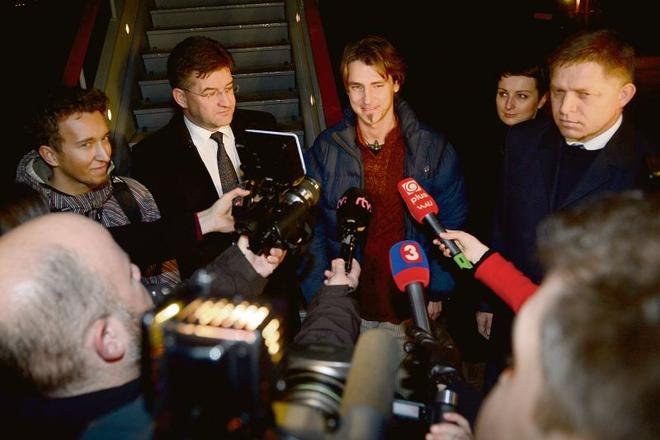AFTER MORE than 200 days in detention in Iran since mid May two Slovak paragliders, Pavol Šeliga and Marek Stolarčík, returned home. The Iranian regime alleged they had engaged in espionage.
Beginning in September, Iran freed six of the eight Slovak travellers who had been held since May, but these two men were held for further investigation. All of the original group claim to have been in Iran as part of a paragliding expedition. Prime Minister Robert Fico declined to say what prompted Iran to release the final two, but Foreign Affairs Minister Miroslav Lajčák said the release did not include any financial transactions, the Pravda daily reported.
The pair returned to Slovakia in the early hours of December 13 on-board a government plane. Fico said that if Slovakia did not get involved in the case and did not make every political, diplomatic and intelligence effort, they would surely not have been released, the TASR newswire reported.
Fico described the negotiations with Iranians as correct. “Even the detainees say that Iranian authorities behaved politely to them,” Fico said, as quoted by TASR.
Šeliga and Stolarčík were handed over to Slovak officials on December 11, TASR quoted the Iranian Mehr newswire as reporting, without giving more details. They were allowed to leave Iran after several hours of intense negotiations, involving Fico and Lajčák, and the main deputy of Iranian president and first Vice-President Es’haq Jahangiri on the Iranian side.
Battle of nerves
Fico said that it was a battle of nerves, as the two paragliders were theoretically released, but it took several more hours to procure all documents necessary for leaving Iran. Lajčák added that the situation was more complex than it seemed on December 12 when they arrived to the country, TASR wrote.
Except for discussing the release of the Slovaks, the delegation talked about potential fields for bilateral cooperation, especially those which are not subject to the international sanction regime, Lajčák said.
He also praised the work of a special team from the Slovak Intelligence Service (SIS) and Ministry of Foreign Affairs, which worked on the case until they were released.
“It is a great feeling to be home finally,” Stolarčík told TASR. Šeliga added that they had regular contact with their families and the Slovak ambassador to Iran during the past few months. According to him, they had met friendly and helpful people in Iran before the detention, and they hope this experience will not contribute negatively to the image of the country, as reported by TASR.
Šeliga is a graduate of the Institute of Nuclear and Physical Engineering of the Slovak University of Technology in Bratislava (STU), as confirmed by the director of the institute, Vladimír Slugeň, and reported in Sme. He currently works for a company dealing with designing security systems for the area of nuclear energy. Stolarčík is an expert in navigation technology, according to Pravda.
The eight Slovaks were detained in mid-May for what Iranian authorities called “illegal activities, such as taking photos of prohibited places” in the Isfahan province, where several key nuclear facilities are located, including at least one plant used for enriching uranium. They are members of Paragliding Expedition Slovakia, a group that has organised several expeditions abroad in recent years, and which made documentary films that they later presented at film festivals. The group claims to have travelled to Iran as tourists in early May.
Iranian authorities confirmed that eight Slovak paragliders had been detained on June 30, saying they were “behaving inappropriately and had unconventional devices with them”, as reported by TASR.
According to Vladislav Frigo, one of the paragliders released in September, they were detained for having dual-band transmitters, adding that “we did not use the band which was banned in Iran. But we had them, so this was what we violated”, the SITA newswire wrote.
Previous incident
Another Slovak national, Matej Valuch, was arrested by Iranian authorities in August 2012 and released in February 2013, appearing at a press conference in Slovakia two days after his release. The 26-year-old was detained over what Iranian officials also alleged was a case of espionage.
Valuch appeared in a video recording called ‘Hunter in Trap [sic]’, shot by the Iranian Ministry of Intelligence and posted on YouTube, while speaking in English, dubbed into Persian. He appeared to confess to working clandestinely for the US Central Intelligence Agency (CIA).
“I want to say that I am not a spy,” said Valuch at the press conference accompanied by Lajčák after returning to Slovakia.
Lajčák said at the time that getting Valuch, who studied business at the bachelor level at Matej Bel University in Banská Bystrica, back to Slovakia did not cost the country a single euro, while thanking his colleagues for what he described as an excellent job working on the case.
Upon his return Valuch told the media that he could not explain why he was accused of being a spy. When talking about his arrest, Valuch said the investigators informed him that the people who had hired him were with the CIA, so he was not detained as a CIA agent, adding that he does not know, and therefore cannot confirm, the real identities of the people he was cooperating with, TASR wrote in February.
Regarding the origin of the video, Valuch said that the Iranians made a short film in September 2012, a few weeks after his arrest, in which he talked about his work in the area of HR and his business projects. They told him they would show the video to someone in a position of high authority who would assist in releasing him.
With press reports
Author: Radka Minarechová with press reports


 The last two paragliders return from Iran. (source: TASR)
The last two paragliders return from Iran. (source: TASR)